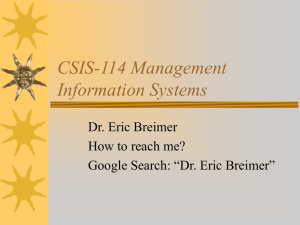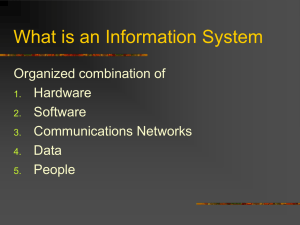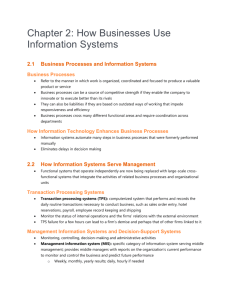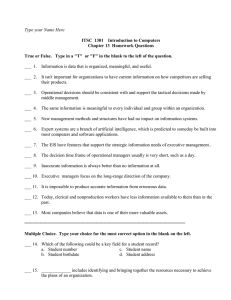CH02.1 (1)
advertisement
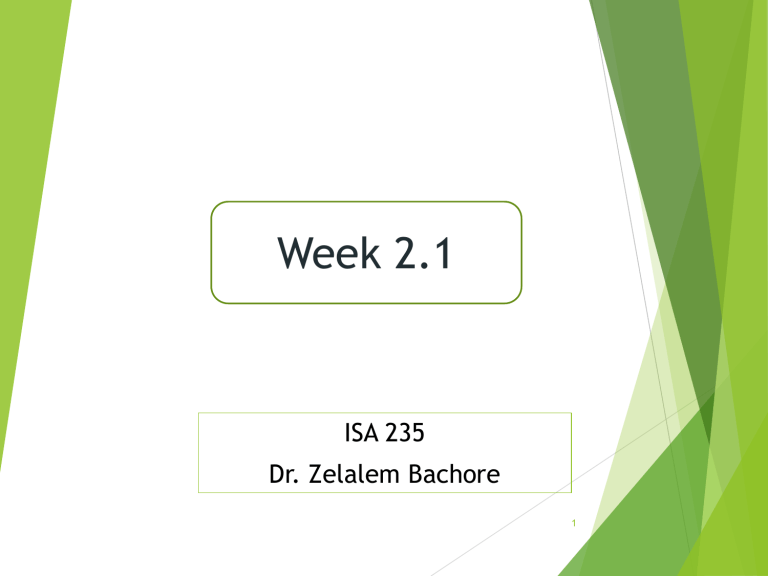
Week 2.1
ISA 235
Dr. Zelalem Bachore
1
SECTION 2.1
DECISION
SUPPORT SYSTEMS
2
CHAPTER TWO OVERVIEW
SECTION 2.1 – Decision Support Systems (DSS)
Making
Organizational Business Decisions
Measuring Organizational Business Decisions
Using MIS to Make Business Decisions
Using AI to Make Business Decisions
SECTION 2.2 – Business Processes
Managing
Business Processes
Business Process Modeling
Using MIS to Improve Business Processes
3
MAKING ORGANIZATIONAL
BUSINESS DECISIONS
4
The Decision-Making Process
An Example of decision-making models…..
- Six-Step Decision Making Process….
5
Decision-Making Essentials
The structure of a
typical organization is
similar to a pyramid
Different
levels
require
different
types of information
Decision-making and
problem-solving occur
at each level in an
organization
6
Decision-Making Essentials
Strategic decision making –
Managers develop overall
strategies, goals, and objectives
Unstructured decisions – Occurs
in situations in which no
procedures or rules exist to
guide decision makers toward
the correct choice
STRATEGIC
7
Decision-Making Essentials
Operational decision making Employees develop, control, and
maintain core business activities
required to run the day-to-day
operations
Structured decisions - Situations
where established processes offer
potential solutions
Structured decisions are made
frequently and are almost repetitive in
nature;
OPERATIONAL
E.g. Reordering inventory, creating the
employee staffing, production schedules
8
Decision-Making Essentials
Managerial decision making –
Employees evaluate company
operations to identify, adapt to,
and leverage change
Semi-structured decisions –
Occur in situations in which a
few established processes help
to evaluate potential solutions,
but not enough to lead to a
definite recommended decision
MANAGERIAL
9
Decision-Making Essentials
Strategic
Level
Managerial
Level
Operational Level
MIS Types
Focus
Knowledge
Internal,
functional
BI
Internal, cross-functional
(sometimes external)
Information
External, industry,
cross company
10
Decision-Making Essentials
Strategic
Level
Managerial
Level
Operational Level
Decision types
Time-frame
Structured, recurring,
repetitive
Short term, daily,
monthly, yearly
Semi-structured,
ad hoc
(unplanned) reporting
Short term, day-to-day
operations
Unstructured,
nonrecurring,
one time
Long term—yearly,
multiyear
11
MEASURING ORGANIZATIONAL
BUSINESS DECISIONS
Project – A temporary activity a company
undertakes to create a unique product,
service, or result
E.g.
Building a railroad, Cleaning a room
If you cannot measure something, you
cannot manage it!
Metrics
– Measurements that evaluate
results to determine whether a project
is meeting its goals
12
Overview of Critical Success
Factors (CSFs) Analysis
A
method developed at MIT’s Sloan
school by John Rockart to guide
businesses in creating and
measuring success
Widely used for technology and
architectural planning in enterprise
I/T
13
What Is a Critical Success Factor (CSFs)?
Rockart:
“In
order for the business to flourish, these things
must go right”
“are
those handful of things that within someone’s
job must go right for the organization to flourish.
They are the factors that the manager wishes to
keep a constant eye upon.”
“an
internal or external business-related result that
is measurable and that will have a major influence
on whether a business segment meets its goals.”
Create high-quality products
Retain competitive advantages
Reduce product costs
Increase customer satisfaction
Hire and retain the best professionals
14
CSFs & KPIs
Key performance indicators (KPIs) – The quantifiable metrics a
company uses to evaluate progress toward critical success factors
(CSFs)
KPIs measure the progress of CSFs with quantifiable measurements.
CSFs are elements crucial for a business strategy’s success.
CSF #1:
improve graduation rates
KPI #1:
Average grades by course and gender.
KPI #2:
Student dropout rates by gender and major.
KPI #3:
Time spent in tutoring15by gender and major.
Efficiency and Effectiveness Metrics
Efficiency MIS metrics – Measure the performance of MIS itself: Doing
things right addresses efficiency—getting the most from each resource
Efficiency refers to how well something is done
Effectiveness MIS metrics – Measures the impact MIS has on business
processes and activities: Doing the right things addresses effectiveness—
setting the right goals and objectives and ensuring they are accomplished
Effectiveness refers to how useful something is
16
Efficiency Vs Effectiveness
If something is efficient, does it also mean it is
effective?
If something is effective, does it mean it is also
efficient?
Which one is more important? Efficiency or
effectiveness?
17
The Interrelationship Between Efficiency
and Effectiveness Metrics
Ideal operation occurs in the upper right corner
18
USING MIS TO MAKE
BUSINESS DECISIONS
Types of Decision Making MIS Systems
19
Operational Support Systems
Transaction processing system (TPS) – Basic
business system that serves the operational level
and assists in making structured decisions
Online
transaction processing (OLTP) Capturing of transaction and event information
using technology to process, store, and update
Characterized
by a large number of short
on-line transactions (INSERT, UPDATE,
DELETE), very fast query processing,
maintaining data integrity
E.g.
ATM, Online banking, Online airline
ticket booking, Sending a text message
20
Operational Support Systems
Systems Thinking View of a TPS
• Source document – The original transaction record
• E.g. canceled checks, invoices, customer refunds,
employee time sheet, etc.
21
• CRUD: Create + Read + Update + delete
Managerial Support Systems
Decision support system (DSS) – Models
information using OLAP to support managers and
business professionals during the decisionmaking process
Online
analytical processing (OLAP) – Manipulation
of information to create business intelligence in
support of strategic decision making
What
kind of analysis can a DSS carry out??
22
Common DSS Analysis Techniques
Variable??
23
Variable??
A data characteristic that stands for a value
that changes or varies over time.
In the following table how many variables
do you see?
create table what_are_variables
(
insert into what_are_variables
fname varchar(20), values
('James', 'John', 50000, 'Student', 18);
lname varchar(20),
salary integer,
update what_are_variables
position varchar(20), set fname = 'New_One'
where fname = 'James'
age number
)
24
Common DSS Analysis Techniques
What_If_Analysis
What-if Analysis is the process of changing one
or more variables to see how the changes will
affect the outcome.
Example:
New
Business: T-shirt printing business
Fixed
cost: Printing Machine $1000.00
Cost/Shirt:
Price:
$5/shirt
??????
Quantity:
A
??????
Assignment #3:What_If_Analysis
25
Common DSS Analysis Techniques
Sensitivity Analysis
Means of identifying the project variables which, when
varied, have the greatest effect on project outcome.
Special case of What-if analysis
Also known as One_At_A_Time analysis
Useful when users are uncertain about the assumptions
made in estimating the value of key variables
E.g. repeatedly changing product cost in small
increments to determine its effect on profit
Used in a wide range of fields, ranging from biology and
geography to economics and engineering.
Sensitivity analysis can provide information to managers
26
about which elements of the business require more
concentration
Video #4: Sensitivity Analysis
What_If Vs Sensitivity Analysis
Similarity??
Both involve changing variables and
study the effect on the outcome
Difference??
The level of change in variables
What_if:
no restriction in changing variable value e.g.
price: $10, $20, $30 ….
Sensitivity:
Variables values should be changed in small
increments e.g. price: $10.01, $10.02, 10.03 ….
Number
of variables
What-if:
update one or more variable at a time
Sensitivity:
27
update one variable at a time
Common DSS Analysis Techniques
Goal-seeking Analysis
Set a target value, and then repeatedly change other
inputs until the target is achieved.
Reverse of What-is and sensitivity analysis
Example:
Goal:
Increase Revenue to from $11,250 to $20,000
Variables:
#
of units: 500
Retail
Assignment #4:Goal_Seeking_Analysis
price: $25.00
Selling
discount: 10%
Question:
How many units need to be sold to
increase revenue to $20,000.00?
28
Common DSS Analysis Techniques
Optimization Analysis
Extension of goal-seeking analysis
Instead
of setting a specific value for a
variable, the goal is to find the optimum
value for one or more target variables,
given certain constraints
One
or more other variables are
changed repeatedly, subject to the
specified constraints, until the best
values for the target variables are
discovered
29
Common DSS Analysis Techniques
Goal Seeking Vs Optimization
Similarity??
Both Focused on the outcome
Difference??
Goal-seeking: End-result may or may not be
optimal
Optimization:
End-result is expected to be
optimal
30
Managerial Support Systems
Systems Thinking View of a DSS
31
Managerial Support Systems
Interaction Between a TPS and DSS
32
USING MIS TO MAKE
BUSINESS DECISIONS
Types of Decision Making MIS Systems
33
Strategic Support Systems
Executive Information Systems(EIS):
A specialized DSS that supports senior-level executives and
unstructured, long-term, non-routine decisions requiring
judgment, evaluation, and insight.
These decisions do not have a right or wrong answer, only
efficient and effective answers.
34
Information Levels Throughout An Organization
Strategic Support Systems
1. Citywide customers
2. Statewide customers
3. Nationwide customers
1. Nationwide customers
2. Statewide customers
3. Citywide customers
1. Product sale during a specific promotion
2. Product sale during ALL promotions
Usually done along a TIME axis
Assignment #5: DSS & EIS/SSS
Alternative Presentations
Swap Rows and Columns
35
Strategic Support Systems
Interaction Between a TPS and EIS
36
USING AI TO MAKE BUSINESS
DECISIONS
Artificial intelligence (AI) – Simulates human
intelligence such as the ability to reason and
learn
DoD pledged 2Billion over the weekend!!
Its ultimate goal is to build a system that can
mimic human intelligence.
Turing Test – Creator of Machine learning.
37
Five most common categories of AI
Expert system Vs DSS?
Imitate the
reasoning
processes
of experts
in solving
difficult
problems
Attempts
to emulate
the
way
the human
brain
works.
E.g. fuzzy
logic
Mimics the
evolutionary, survivalof-the-fittest process
to generate
increasingly better
solutions to a
problem. Used in
situations with
thousands of
possible solutions
E.g. trading decisions
Special-purpose
knowledge-based
information system
that accomplishes
specific tasks on
behalf of its users
E.g. shopping bots:
find products,
bargain over prices
and execute 38
transactions
A computersimulated
environment that
can be a
simulation of the
real world or an
imaginary world

